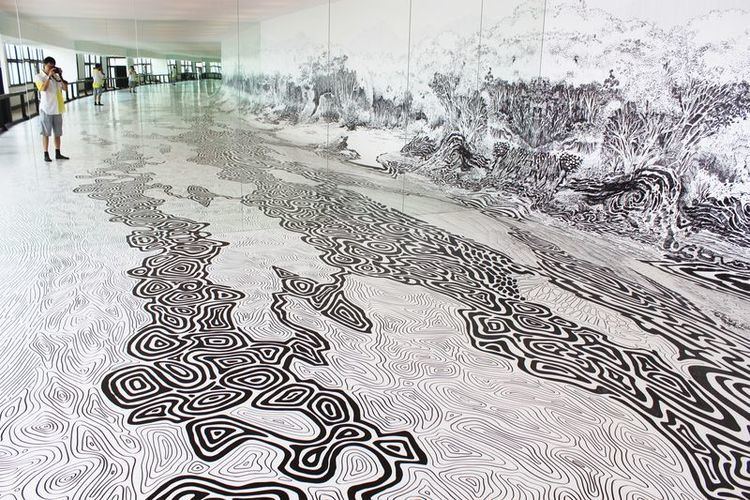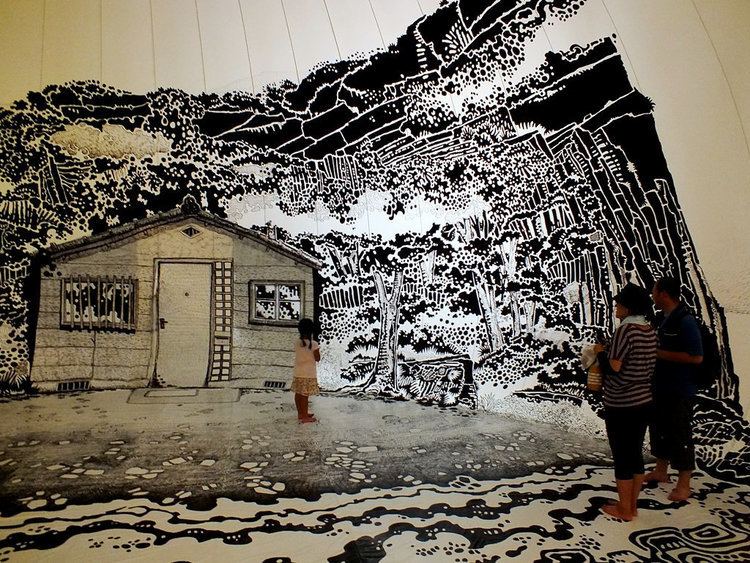Nationality Brazilian, USA Name Oscar Oiwa | Movement Globalism | |
 | ||
Born August, 1965 Sao Paulo, Brazil Known for painter, visual artist, architect Education University of Sao Paulo (1983–1989) Awards Guggenheim Fellowship for Creative Arts, US & Canada | ||
Ibuki project by oscar oiwa 2013
Oscar Oiwa (in Japanese: 大岩オスカール) is a painter who was born in Brazil, son of Japanese immigrants. He received his B.F.A. (1989) from the School of Architecture and Urbanism, São Paulo University. Oiwa was influenced by comic books, art, and magazines throughout his youth, as well as the urban environment of his birthplace. He experienced contemporary art during this time in nearby galleries and became an assistant at the São Paulo Art Biennial. Oiwa held his first solo exhibition while he was still in college and thereafter participated in the 21st São Paulo Art Biennial (1991).
Contents
- Ibuki project by oscar oiwa 2013
- Oscar oiwa arte sem fronteiras
- Globalism
- BooksExhibition Catalogs
- References

He currently lives and works in New York City, though his artwork has been exhibited worldwide. He has had over 60 solo exhibitions since 1990, including Arizona State University Art Museum, Museum of Contemporary Art Tokyo, Fukushima Prefectural Museum of Art, Takamatsu City Museum and Museu Nacional de Belas Artes in Rio de Janeiro.

Selected public collections: The National Museum of Modern Art, Tokyo (Tokyo), Museum of Contemporary Art Tokyo (Tokyo), Mori Art Museum (Tokyo), Yokohama Museum of Art (Kanagawa), Toyota Municipal Museum(Aichi), Hiroshima City Museum of Contemporary Art(Hiroshima), Hyogo Prefectural Museum of Art(Hyogo), 21st Century Museum of Contemporary Art, Kanazawa(Ishikawa), Utsunomiya Museum of Art (Tochigi), Phoenix Museum of Art(Arizona), Arizona State University Art Museum (Arizona), Prince Albert II of Monaco Foundation, University of São Paulo Museum of Contemporary Art (USP).

Represented Gallery: Art Front Gallery (Tokyo), Tokyo Gallery+BTAP (Tokyo, Beijing), Gallery Caption (Gifu), Keumsan Gallery(Seoul), Connoisseur Contemporary (Hong Kong). He has received several awards including Pollock-Krasner Foundation grants, John Simon Guggenheim Memorial Foundation Fellowship (2001) and Asian Cultural Council in 2002.

Oscar oiwa arte sem fronteiras
Globalism

Born in São Paulo in 1965, Oiwa relocated to Tokyo in 1991 after graduating from the university. After ten years in Japan, interrupted by a year spent in London, he moved to New York in 2002 and has since made that city his base of operations. His decision both times to relocate to another country was motivated by a desire to expand his activities as an artist, he says. At this suggests, Oiwa has always been a self-motivating artist, sure of his needs, when it comes to his movements. Among 20 years of art production starting from São Paulo days, Oiwa’s oeuvre includes everything from texts, paintings, and art objects to fictional narrative-based installations, conceptual works patterned after kits, public art, and book production.

Oiwa's works present us with a world closely familiar and yet completely unexpected. As is often said, it is a world constructed of dissimilar or opposing elements that, although starkly different, coexist. Behind the interest Oiwa's works give to people is the breadth of vision with which he connects these innumerable elements - their amplitude, in other words.

The coexistence of naturalist representation and the fabled-fantastic datum is one of the typical aspects of Oiwa’s paintings – one that approximates his production to Brazilian and Latin American literary tradition, of so-called magic realism. The realm of authors such Jorge Amado, Alejo Carpentier, Isabel Allende or Gabriel García Marquez, to mention only a few among the most celebrated, is characterized by a similar oscillation, that is to say, by the coexistence of meticulously naturalist descriptions, often deeply engaged from the social political standpoint, and passages of fantastic literature, replete with ghosts, miracles, and metamorphoses. Here, the possible and the impossible seem to live in harmony; the absurd and the inexplicable become plausible, and the fabulous become natural and even expected, exactly like in Oiwa's pictures. The joyful and yet menacing giant flowers that hover over New York in Gardening (Manhattan) (2002), or the black snow that falls over São Paulo in Black Snow (1997) are majestic, biblical events comparable to the insomnia and amnesia that afflict the inhabitants of Macondo in García Marquez’s One Hundred Years of Solitude; or, even more tangible, to thousands of notes scribbled with names of all things, that they post everywhere in their desperate attempt to halt memory loss.
The kinship of Oiwa’s painting with a typically Latin American literary genre should not suggest a reductionist or regionalist reading of his oeuvre. On the contrary, among the Brazilian artists of his generation, Oscar Oiwa is certainly one who most rapidly and effectively became independent from the local context, having lived the better part of his life and built his artistic career between Europe, Japan, and the United States. Way beyond the Latin American context, the simultaneity of distinctive records in combination with the richness of sources and references attest to the globalized and postmodern character of Oiwa’s painting – provided we view him as an artist undergoing constant, contradictory and ironical transformation, permeable to the most diverse stimuli.
Many art writers have called his work criticism of globalization, something that has also been called the cause of 9/11. Oiwa, however, says globalization is not entirely bad. In fact, this globe-trotting artist may be the epitome of globalization; his artwork as a look at the world simultaneously from the inside and out.
Ever the ecumenical, Oiwa directs his wit to the broader political community. In G-8 Meeting, 2007, he places mascots for the most powerful countries of the world in a garden setting. They seem to have arrived by yacht. The telltale Oiwa remind us of the way the rest of the world lives with a heap of rubble huddled in the lower-right corner. An elegant mansion suitable for such a summit meeting is in the background. Over all, a lovely pattern of snow dapples the sky in much the way that pattern works on Azuchi–Momoyama period decorative screens. The players are gathered on the lawn to have a picnic, or divide the spoils. It is a union of cartoon superheroes. Italy is represented by Valentine, an anime babe wielding a camera as if it were a machine gun, her bandolier of film and gadgets across her bare breasts. Her boots in a camouflage pattern nearly reach the bottoms of her bikini panties. Asterix le Galois, representing France, is dressed like an escape from Walkyrie. He toasts the representative from the United Kingdom, Wallace, who is eating. They have a bottle of champagne on ice. In the foreground, a demur Misha, the bear from the Olympics, is Russia. Then there are the bodybuilders in leotards. Japan is represented by the special-effects film star Ultraman. The United States is Captain America, with big American feet, and Germany hanging on for dear life. Looking like a cousin of the American, Captain Canuck, in red and white, represents Canada. In the background, as obedient as a Zen monk, Mafalda is sweeping. The Argentine comic strip began in the 1960s features Mafalda, a six-year-old working-class Argentine girl who has strong opinions about contemporary politics. This idealist with a left-of-center point of view dreams of working as an interpreter for the United Nations when she grows up. Here instead of playing the role, she is consigned to cleaning up after the G-8. The lone representative from Latin America, she is not a guest but a servant.
He is not the first artist to record the impact of globalization but is among the most experienced of them not only for his skill as painter but for the complexity of his view of the transformations that have occurred as a result of unbridled extreme of human ambition. He reflects on the passive acceptance of change and the gradual deformation of the environment, especially of cities, the tight-knit, human-built megalopolis that refers to no specific city but instead suggest many. He does not simply scold and accuse. He shows us a world in which cultures fuse with some, overpowering and contaminating others. He makes scenic paintings about cultural collision, environmental degradation, dehumanizing slums, and violence through attrition.
Oiwa works in modules, each panel 227 × 111 cm (7.45 × 3.64 ft). While living and working in Japan, he uses the dimensions of the traditional tatami: 91 × 182 cm (2.99 × 5.97 ft). But when he moved to London in 1996, he translated this idea into English by opting for the size of the British sheet of plywood. He lines up the panels edge-to-edge, to make a painting from one to six panels. The system is not only convenient for shipping and storing, it takes advantage of the benefits of a grid, giving a sense of order against which Oiwa’s panoramic and often apocalyptic vision unfurls.
